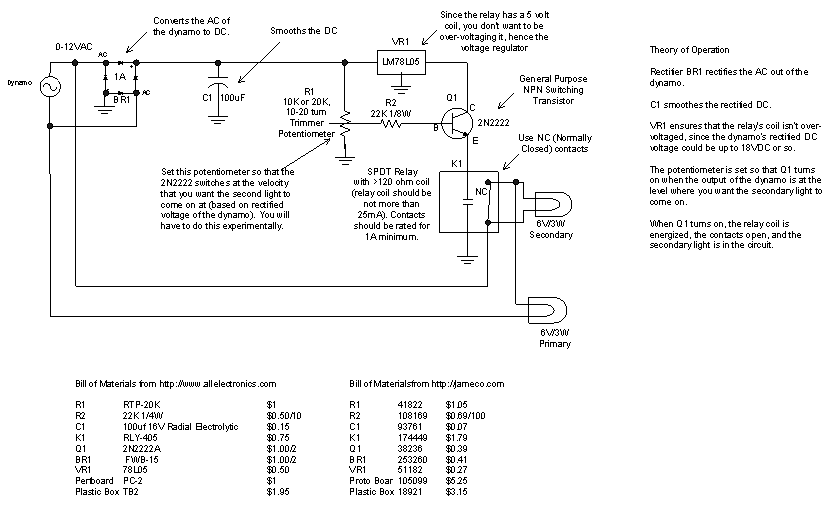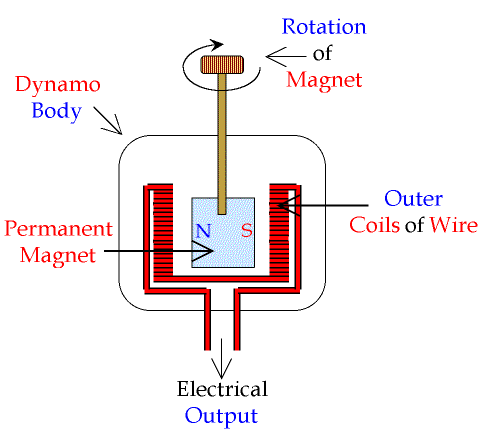
Dynamo Powered Lights
A sub-page of http://bicyclelighting.com

Bicycle Dynamo
| Introduction |
| Facts about Dynamo Systems |
| What the Experts Say about Dynamos versus Battery Powered Lights |
| Dynamo Systems |
| Mounting Dynamo Headlamps |
The main purpose of this web site is to explain how to construct a high performance battery powered lighting system. I’ve gotten some not-so-nice e-mails, and seen some bizarre-logic Usenet posts, that promote dynamo powered bicycle lighting systems. While I also use dynamo lights on occasion, I believe that it's important to understand the facts regarding dynamo systems and battery based systems, so you can choose the most appropriate lighting system for your needs.
These e-mails and posts show that there are some dynamo users who's views on dynamo lights center around the idea that "I use them, so they must be fine, and anyone that disagrees with me is wrong because I say so." When people are so defensive, it's because they are insecure about their own choices. I decided to add this section on dynamo powered lights, so the reader can get an unbiased evaluation of the pros and cons of dynamo powered lights.
|
|
Return to Table of Contents |
|
e-mail webmaster |
|
Facts about Dynamo Systems
This is a sensitive subject, so I'll try to present the facts
in a clear and unbiased manner, though I expect that some people still won't be
happy.
What’s Wrong With Dynamo Powered
Lights
In my view, and in the view of many bicycle safety experts, dynamos are
usually not an attractive option. This is for reasons of both cost and
performance. Decent dynamo light sets are much more costly than decent battery
powered lights, and the battery powered lights have vastly superior illumination
than even the most expensive dynamo powered system. The problem is that a dynamo
driven by a bicycle is very limited in the amount of power that can be
generated.
What’s the Attraction to Dynamo
Powered Lights?
The attraction of dynamo powered lights is obvious; you are self-sufficient
and there is no limit to the duration that the lights can be used. Some
individuals believe that having to rely on mains power for bicycle lighting is
somehow cheating. Purists may be willing to spend the additional money for a
high end, 6 watt, dynamo system, or live with the lower performance and lower
safety provided by a 3 watt dynamo powered system. Of course a few of these
people will hotly dispute the contention that a 3 watt system is less safe than
a higher power system, but the bicycle safety experts do not agree with this
contention.
In well lit cities where the cyclist is familiar with their route, a dynamo system is often sufficient. However due to the power generation limits of a bicycle dynamo, it simply is not possible to generate enough power for lights that are bright enough for use on dark or unfamiliar routes. Another factor is that as we age, our night vision deteriorates, and brighter lighting is necessary for safety. Personally, I do own a dynamo. It's fine for going around a familiar town at night, and eliminates the need to worry about batteries. However I would never use it on dark or unfamiliar routes.
Types of Dynamos
There are three types of dynamos available, each with different attributes.
Bottle Dynamos
Dynamos that rub against the tire rim have a few undesirable properties.
They are noisy, they can slip when wet, and they wear the sidewall of the tire.
The problem of slippage was solved on the higher end dynamos by the optional use
of a material that provides more friction with the tire (which increases the
wear even more). On a tire with thick sidewalls the wear is not such a big deal.
On a lightweight tire with thin sidewalls, the wear will require more frequent
tire changes. Bottle dynamos remain the most popular type.
Bottom Bracket or “Roller”
Dynamos
This dynamo is mounted near the bottom bracket and contacts the tread of
rear wheel. This dynamo does not wear the tire sidewall, but the location near
the ground subjects it to dirt and moisture. Some touring bicycles have wiring
through the frame, from the bottom bracket area up to the headset, for bottom
bracket dynamos (I have an old touring bicycle with this feature). These dynamos
are no longer popular, but they are still available from Union and a light set
with this dynamo is $70 and includes a 2.4W headlight, and 0.6W tail light. see:
http://www.bicycletires.com/tek9.asp?pg=products&specific=jqhoeri0.
Hub Dynamos
Dynamos encased in the hub of the wheel have made a resurgence recently.
These work in any weather and they do not wear the sides of the tire. They
produce some extra drag even when they are not engaged, but the additional drag
is minimal. Retrofitting a hub dynamo means building a new front wheel with your
existing rim and a new hub and new spokes.
Dynamo Comparisons
http://myra-simon.com/bike/dynotest.html This site is a bit out of date, but it is still a good source of
information.
Where did 3 Watts Come From?
How did 3W dynamo systems become so pervasive? In 1950, the German
government decreed that 3 watts was the amount of lighting required on bicycles,
and mandated a minimum of 3 watt generator powered lights. In fact they actually
required that the bicycle have a generator, though approved battery powered
lights could also be used.
In the past 53 years, much has changed in the world. Vehicle lights have increased significantly in brightness, culminating with the popular HID systems on luxury cars. Bicycle lighting has kept pace, with better and better lighting options, but increased brightness has come at a price. Dynamos are no longer able to provide sufficient power for bicycle lighting. In a way, this is sad, since self-sufficiency in terms of production of power for bicycle lights is gone.
Why can’t someone make a dynamo
that produces more power?
They can, but it would create so much drag that it would be impractical. A
human can produce about 125 watts of power by pedaling (one-sixth horsepower).
Most of the power input on a moving bicycle is used to overcome road resistance
and wind resistance. Even a 3W generator adds a noticeable amount of drag. A 20W
generator would be very heavy and create an undesirable amount of drag. If you
really want to experiment with this, a good starting place are the small 12V
generators (DC) which were used on older Volkswagen vehicles. These are
available for about $70 from JC Whitney. You’ll have to fabricate a way to drive
the shaft of the generator at the proper speed.
What about Low Speed Power with
Dynamos?
This issue was brought up in dynamo tests. This issue is relevant on hills, when
there are strong headwinds, on bicycle paths where it isn't possible to ride at
a higher velocity, or simply when the rider is a slower rider.
"That's the kind of speed an average rider gets down to on a steep hill. An elderly or disabled rider might often be reduced to such a low speed by an incline or headwind. And it may difficult to ride much faster on some cycle paths, where poor surfaces, sightlines and obstacles make a good light all the more important! " (Low speed power analysis at http://myra-simon.com/bike/dynotest.html)
“Being Seen” Lights to Supplement
a Dynamo Powered Lighting System
If you choose to use a dynamo powered lighting system then it should be
supplemented with additional front and rear "being seen" lights, because dynamo
lights are particularly unsuited for “being seen.”
Front and rear xenon strobes are available at http://www.lightmanstrobes.com/hp_kit.htm. The batteries in these strobes should not be used once the strobe frequency begins to decrease. Using rechargeable NiMH AA cells is a good idea. Another option is an LED blinker, but most of these blinkers have undesirable characteristics that render them unsuitable for bicycle commuting. The best option for an LED blinker is the $40 Real Lite, described above.
Of course, once you add strobes and LED blinkers, you're back to batteries anyway, and have spent far more money than necessary.
|
|
Return to Table of Contents |
|
e-mail webmaster |
|
What the Experts Say about Dynamos versus Battery Powered Lights
Click for Expert's Views on Dynamos versus Battery Powered Lights
|
|
Return to Table of Contents |
|
e-mail webmaster |
|
Dynamo Systems
Since some people want dynamo lights for touring or
commuting, I have included information on what's available. The two premier
sources of dynamo lights are
Yellow Jersey, and
Peter White Cycles. These
companies also sell battery powered lights.
Top Quality Dynamos
Best 12V Dynamo--Busch-Muller
Dymotec S12 (12 volts/6 watts)
The best quality bicycle generator light set is
based on the Busch-Muller Dymotec S12 12 volt dynamo. This dynamo can power a 5W
headlight and a 1W tail light. The price for this system is quite high. The
dynamo sells for $250. Available in the U.S. from
Peter White Cycles. This dynamo works even with wet tires (a big problem
with dynamos is slippage when wet) due to its clever friction wire material
(replaceable). There is also a 6 volt version of this dynamo, but it only
produces 3 watts which is really not sufficient for road riding in urban
environments.
Best 6V Dynamo--LightSpin (6
volts/4.5W) [NOT CURRENTLY AVAILABLE]
The LightSpinTM uses a switching regulator and a micro-controller
to significantly boost efficiency. If you want the least drag in a 6V system,
this is the best choice, with less drag than a hub dynamo. It is rated at 50%
more power (4,5W) than other 6V dynamos (3W). It can charge an optional storage
battery while at the same time powering 3W lamps, since it can produce 1.5W more
than the 3W that a front 2.4W plus rear 0.6W system requires (I wonder if it
could drive two 2.4W lamps without a rear lamp or optional battery). It's a good
deal, relatively speaking, at $120. Available in the U.S. at:
http://www.yellowjersey.org/litespin.html. This dynamo is very popular,
and is in short supply. Note that since this is a 4.5W dynamo, even with the
increased efficiency it will be more work to drive it.

Alas, this dynamo appears to no longer be available. I guess the market for $120 dynamos was just not big enough, though Yellow Jersey didn't seem to have any problem selling as many as they could get.
3 Watts worth of Lights
The less expensive 3W generators are used
to power a 2.4W headlight and 0.6W tail light. However you can eliminate the
taillight and increase the headlight to 3W. Then add a battery powered rear
xenon strobe or Real Lite LED flasher. You should also add a front xenon strobe
if using a 2.4-3W headlight; this will solve the "being seen" problem inherent
to the very low power headlamps, a 2.4-3W light is not bright enough to stand
out in a sea of bright lights.
A 6 volt, 2.4W spot beam headlamp, as typically used with lower cost generator lights, is certainly better than no lighting at all. It is not as nearly as good as a system that provides both wide angle and spot beam coverage at higher candlepower. The 2.4W spot beam is especially good for illuminating the road directly in front of the bicycle (for a short distance, suitable for slow riding), but is especially poor in terms of being seen, where a wider beam pattern is necessary, and is not good for high speed riding. As stated above, if using a 2.4-3W dynamo powered headlamp then consider adding at least a battery powered clear xenon strobe to the front of your bicycle as well.
Click Images for Details
 |
|
| Busch-Muller Dymotec S12, 12 volt 6W dynamo. Available from Peter White Cycles. Very expensive. | Note the low power headlamp powered by the dynamo on the front wheel. Also, this bicycle has a skirt guard, which is common on Dutch Roadsters, but darn near impossible to find in the U.S.. While riding without clothes is common in rural areas of the Netherlands (in warm weather), it is not recommended that you try this in the U.S.. |
A selection of mid-quality generator lights based on Sanyo and Sanden generators are available for $40-60 from International Bike Lights, http://www.bikelite.com/ Several of these models feature adjustable beams which is a very good feature.
Harris Cyclery sells the Shimano-Nexus generator hub, the 6 volt Busch & Müller generators, as well as a selection of lights that can be used with these generators.
Mid-Quality Dynamos
The mid-quality Union 6 volt generator light set is available at: http://store.bicyclerevolution.com/unbicliggens.html for $50, and for $33.25 from Third Hand. This unit has a build in voltage regulator to avoid bulb burn-out at high speed, or if the tail light burns out.
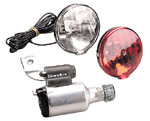
El-Cheapo Dynamos
A low end 12 volt generator is available for $16 at: http://doityourself.com/store/6825749.htm. This comes with low quality lights, and the dynamo isn't so great either. No voltage regulator. Also sold at many hardware stores and toy stores.
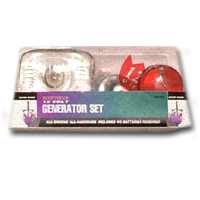
Another low end 6 volt ($25) and another low end 12 volt ($30) system is exported from India by Eastman Impex. You can see these over at: http://www.yellowjersey.org/lolite.html. The seller is quite honest, stating that these are "Bicycle Dynamo Lighting Sets of Low Quality and Commensurate Low Price"
Bottom Bracket Union Generator Light Set
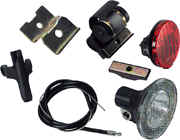
$70 from http://www.bicycletires.com/tek9.asp?pg=products&specific=jqhoeri0
Lamps for High End Dynamos
It's too difficult to keep track of the changing availability and pricing of dynamo headlights. See http://www.peterwhitecycles.com/schmidt-headlights.asp#pricing for details. Prices range from about $40 for the cheapest Lumotec, to $130 for the Inolight 2 watt LED headlight.
|
|
Return to Table of Contents |
|
e-mail webmaster |
|
There are four places to mount dynamo headlamps. They can be mounted to the fork blade, using a Cronometro Nob that simulates a piece of handlebar (see http://www.peterwhitecycles.com/dualsetupfork.htm). They can be mounted to the fork crown using a steel or aluminum bracket. They can be mounted to the handlebars using a nylon bracket. They can be mounted to a reflector bracket that can be installed on bicycles with threaded headsets.
There are trade-offs for each mounting choice. Suffiice it to say, mounting the headlight as low as possible, from the handlebars, is the best option. According to Peter White's web page, the fork crown mounts sometimes experience breakage from metal fatigue, especially with the heavier headlights. Fork crown mounts also are subjected to dirt and water thrown up by the front wheel, so a fender is advised for fork mounted lights. See Peter White's page on mounting headlights at http://www.peterwhitecycles.com/light-mounts.asp.
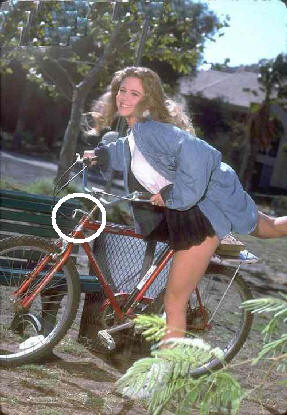
Look at that steel reflector bracket just
waiting for a nice headlight to be attached to it.
This girl needs a Mixte frame if she's going to ride in that skirt!
|
|
Return to Table of Contents |
|
e-mail webmaster |
|
Ouch, This is Getting Expensive!
No question, you will literally spend many hundreds of dollars on a high-quality, dynamo based system. By the time you buy the headlights, tail lights, standlight battery (if no integrated standlight), you're looking at a starting price of about $200. If you want to go with a hub dynamo, or a 12 volt Dymotec dynamo, you're up to at least $400.
On the other hand, everything is relative. If you're using your bicycle as your primary vehicle, $400 isn't outrageous at all. These components aren't made in a sweat-shop in China, they're manufactured in small quantities, in Europe. The very weak dollar contributes greatly to the high cost in the U.S., and it will only get worse, as George W. Bush, and his Republican cohorts, drive the U.S. into deeper and deeper economic troubles in his second term, with more record deficits and ill-advised foreign adventures.
|
|
Return to Table of Contents |
|
e-mail webmaster |
|
Automatic Switching of an Additional 6V/3W Lamp
One workaround to the brightness issue
with dynamo lamps is the addition of a second lamp, in series, when the dynamo
is capable of supplying sufficiently high voltage and current to power two 3W
lamps in series (or a 3W secondary plus a 2.4W primary in parallel with a 0.6W
tail lamp). The SON dynamo is capable of producing 12V/0.5A/6W at about 12MPH.
See:
http://www.m-gineering.nl/son12vg.htm.
Normally, over-voltage protection on dynamo systems is contained within the lamp, by means of a voltage limiter (zener diode), and the dynamo will be able to provide higher voltage when two 6V lamps are in series. This will not work if the dynamo is electronically regulated (in which case the lamps don't have to be). The most efficient dynamo, by far, is the Swiss-made LightSpin, which is electronically regulated at 6.3 volts, and which puts out 4.5W. It might be possible to put two 2.4W lamps in parallel. The LightSpin appears to have a switching regulator with a custom ASIC controller. Rather than dumping off excess energy as heat, it reduces drag by converting only as much energy as required for the lamps. It can also charge a small storage battery.
There are many different circuits that can accomplish this task A low resistance potentiometer connected directly to a relay coil would not be efficient, even though it could work; you really want to use a switching transistor or a voltage comparator.
One method of automatic switching is to detect the dynamo's output voltage and switch in a second lamp based on the voltage level. The schematic below is one (untested) method. Again, this circuit is untested, so it may require some tweaking. I've used similar circuits with the 2N2222 transistor to do stuff like this.
You set the trimmer potentiometer so the transistor switches on and energizes the relay, at the velocity where the dynamo is providing sufficient energy for two lights.
Note that you want to keep the lamps operating on AC, for maximum efficiency.
